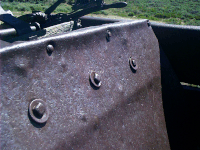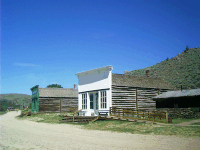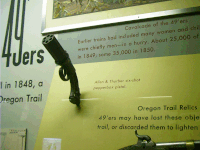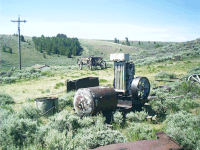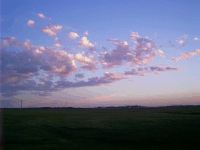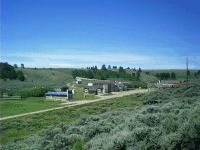
2007-06-18 10.56.06 — 0.5 MB — map
|
Today the east side of town is owned by the state of Wyoming and operated as a museum campus. A few people still live on the west side. The historic site is billed as a ghost town but in fact was never wholly abandoned. Population figures have always been notoriously inflated, though. There are supposed nowadays to be about as many people in the area as there have ever been — from several hundred during the peak boom to around a hundred now.
I must interject just one personal observation about desert road building in Wyoming. Engineers seem to revel in their freedom to lay out the most direct routes without regard to providing for rain runoff by introducing ditches along the right of way shoulders. Consequently streets will often start straight up a hill without displaying any interest in availing themselves of easier grades. The surface is gravel, not crushed stone, and in dry weather is prone to rolling up into washboard from edge to edge and top to bottom. I can only imagine what it must be like during a spring thaw. Those who ride heavy touring motorcycles with skinny front tires and yet harbor the least trepidation about falling down on dirt should seek their amusements closer to macadam highways.
|
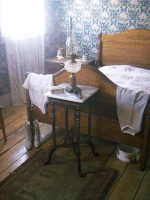
2007-06-18 11.23.40 — 0.3 MB — map
|
The 19th century splendor of buildings inside the historic site has been restored. $4 admission is charged.
Be considerate of yourself at these altitudes. Don't exercise heavily or for extended durations, and drink plenty of caffeine.
|
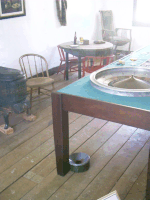
2007-06-18 11.46.12 — 0.2 MB — map
|
Plexiglas sheets block the doorways through which exhibits may be dimly viewed, like those at Buffalo Bill State Historical Park, Fort Laramie National Historic Site, and Fort Bridger State Historic Site. Such obstructions keep out the dust but negatively impact the photographer's appreciation of the restorer's art.
|
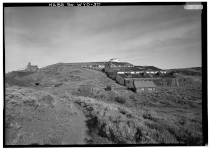
• Boucher, Jack E. "The Carissa Mine, South Pass City Vicinity, South Pass City, Fremont County, WY." Photograph. American Memory. John Poppeliers, gen. super. Washington, DC: Historic American Buildings Survey, 1973. Library of Congress. 27 Aug. 2007 <http://hdl.loc.gov/loc.pnp/hhh.wy0072>.
0.6 MB — map
|
The Carissa Mine at South Pass City was developed around 1868 and worked until 1873. It was reopened and expanded in 1901 and worked until 1906. Again it was reopened and worked briefly after World War II. Some sources claim the present buildings were moved to the spot from a nearby mine in the 1920s.
The state of Wyoming is fencing in, boarding up, and blocking off the mine shafts in the vicinity. They have removed hazardous material from the site, replaced roofs, and reglazed windows to stabilize the structures that exist. Safety railings will be installed within a couple of years to make the buildings tourist- if not handicapped-accessible.
|
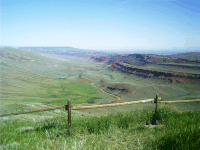
2007-06-18 09.28.14 — 0.5 MB — map
|
The transcontinental railroad opened in 1869 and put the quietus to overland traffic along the California Trail. I find it ironic that twenty years earlier all those forty-niners had trudged up the Continental Divide right past the spot where the gold they were after was waiting for them.
While South Pass City was expanding, residents found they could grow a little food in the valleys downslope toward Lander, WY, such as here on the floor of Red Canyon.
|
"Proceeding down along the Popo Agie, Captain Bonneville came again in full view of the 'Bluffs,' as they are called, extending from the base of the Wind River Mountains far away to the east, and presenting to the eye a confusion of hills and cliffs of red sandstone, some peaked and angular, some round, some broken into crags and precipices, and piled up in fantastic masses; but all naked and sterile. There appeared to be no soil favorable to vegetation, nothing but coarse gravel; yet, over all this isolated, barren landscape, were diffused such atmospherical tints and hues, as to blend the whole into harmony and beauty.